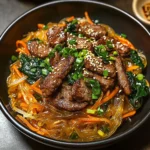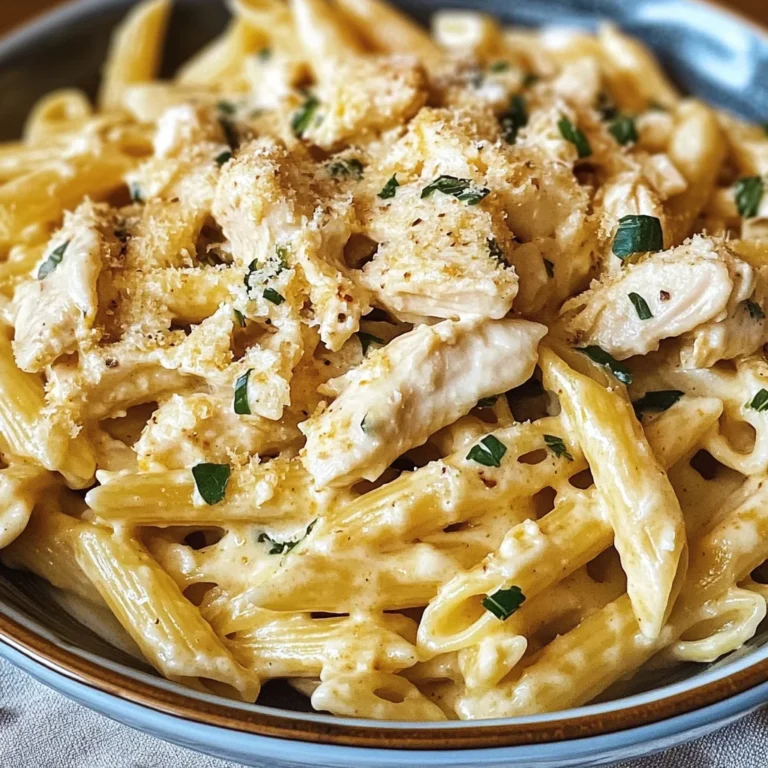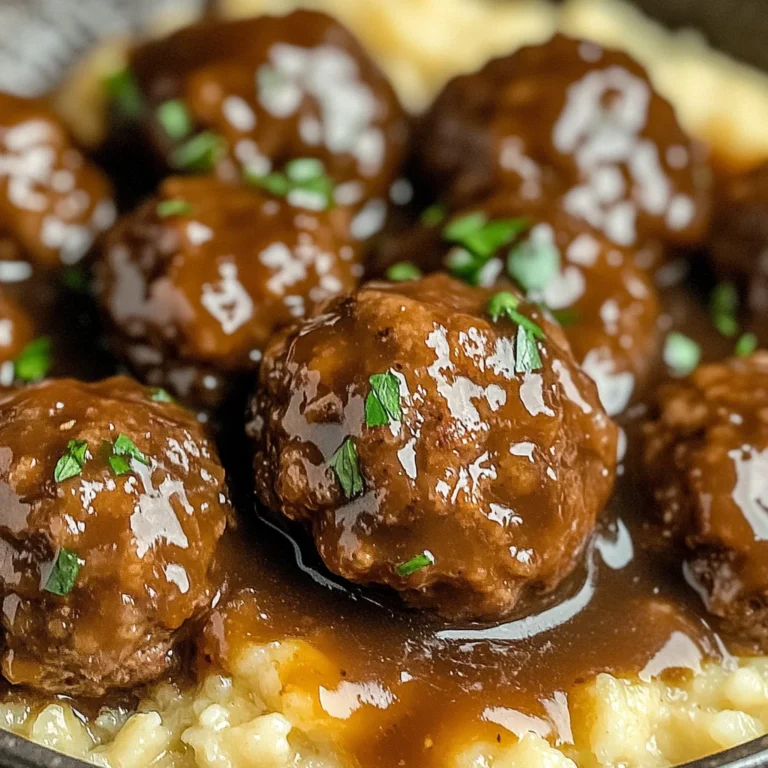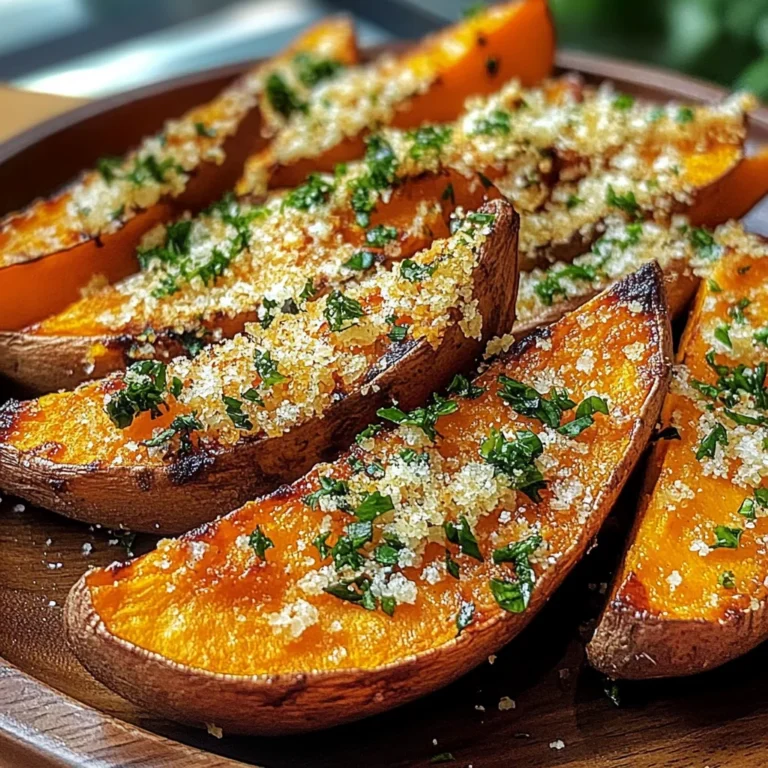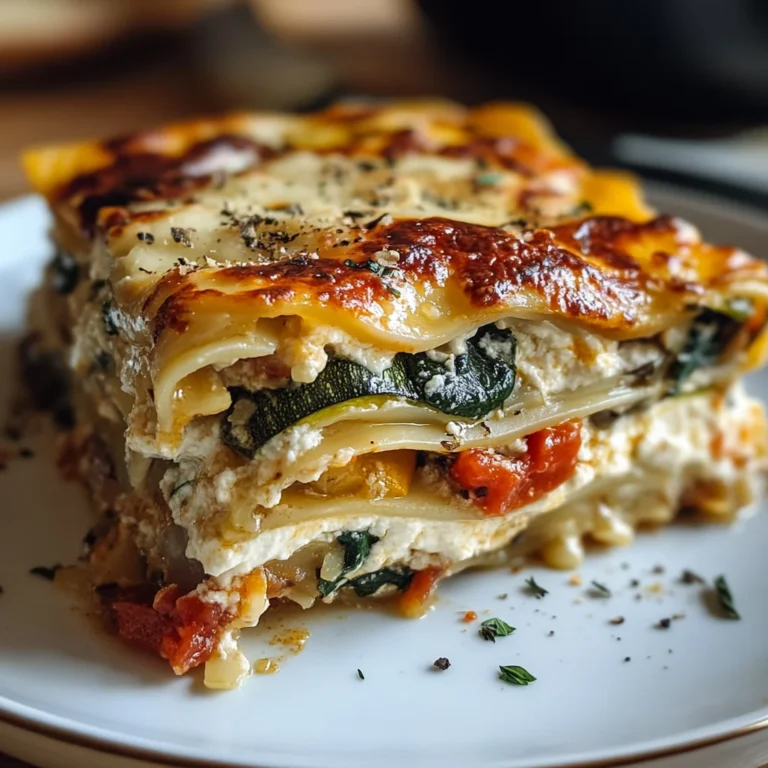Japchae
If you’re looking for a delicious and comforting dish that brings the family together, Japchae is your answer! This traditional Korean recipe is packed with flavor and texture, featuring those delightful sweet potato glass noodles that everyone loves. It’s a meal that feels special enough for gatherings yet simple enough for busy weeknights. Trust me, once you try this recipe, it’ll become a cherished favorite in your home.
Japchae is incredibly versatile, allowing you to customize it with your choice of proteins and veggies. Whether it’s a cozy dinner or a festive occasion, this dish is sure to impress! Let’s dive into the details of making this wonderful meal together.
Why You’ll Love This Recipe
- Easy to Prepare: With just a few simple steps, you’ll have a flavorful meal ready in no time!
- Family-Friendly Appeal: Everyone will love the chewy noodles and colorful veggies—perfect for picky eaters!
- Make-Ahead Convenience: You can prepare Japchae in advance and reheat it, making it great for meal prep or potlucks.
- Delicious Flavor: The combination of savory soy sauce and aromatic sesame oil creates an irresistible taste that will leave you craving more.
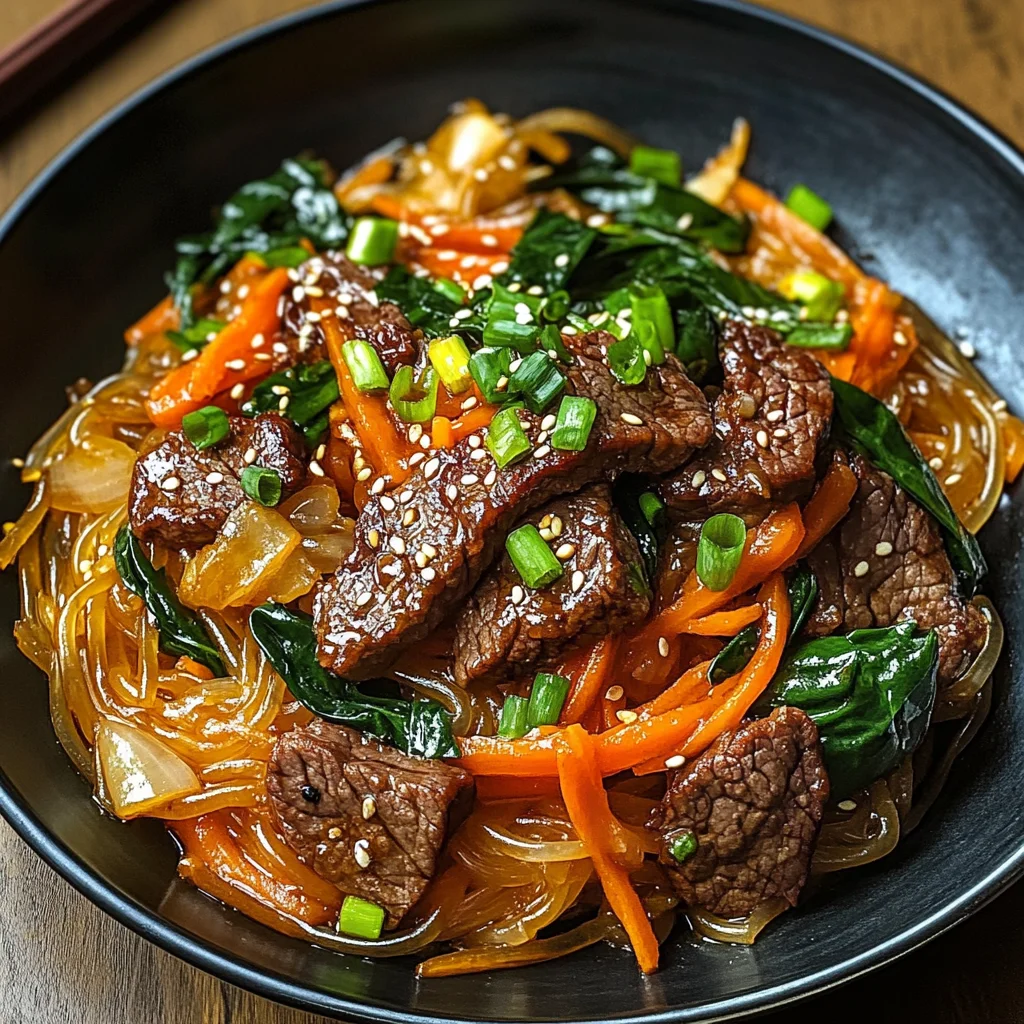
Ingredients You’ll Need
Gathering the right ingredients is a breeze! You’ll find that these are simple, wholesome items you can easily pick up at your local grocery store. Let’s take a look at what you need to make this lovely Japchae:
For the Noodles and Protein
- 2 lb thin-sliced beef (or substitute with chicken, tofu, or shrimp)
- 1 lb Korean sweet potato noodles (glass noodles)
For the Vegetables
- 3 medium carrots, julienned
- 1 large white onion, thinly sliced
- 1/2 bunch green onions, chopped
- 6 garlic cloves, minced
- 1/2 lb spinach leaves
For the Sauce
- 4 tbsp sesame oil (divided)
- 1 tbsp olive oil
- 6 tbsp soy sauce (or tamari for gluten-free)
- 3 tbsp brown sugar
Variations
One of the best things about Japchae is its flexibility. You can easily change up ingredients based on what you have on hand or personal preferences. Here are some fun ideas:
- Swap the protein: Feel free to use chicken or tofu instead of beef for a lighter option!
- Add more veggies: Try adding bell peppers or mushrooms to give it extra flavor and nutrition.
- Spice it up: If you like some heat, mix in a bit of gochujang for a spicy kick.
- Make it vegan: Simply replace the beef with tofu and ensure your soy sauce is plant-based!
How to Make Japchae
Step 1: Cook the Noodles
Start by bringing water to a boil in a large pot with a drizzle of olive oil. Add your Korean sweet potato noodles and cook them for 5-6 minutes until they’re tender but still chewy. This step is crucial because those beautiful glass noodles are what make Japchae so special! Once cooked, drain them well and set aside.
Step 2: Prepare the Beef
In a skillet over high heat, cook your thin-sliced beef until browned. Season it with half of the soy sauce, sesame oil, and brown sugar while cooking. This helps infuse flavor directly into the meat. Once nicely browned, set it aside so we can focus on the veggies next!
Step 3: Sauté the Vegetables
In another skillet, heat some olive oil before adding in your julienned carrots and sliced onion. Sauté them until softened; this releases their natural sweetness! Then add the remaining soy sauce, sesame oil, and brown sugar along with garlic and green onions. Cook for an extra minute to let those flavors meld together beautifully.
Step 4: Add Spinach
Now it’s time to add your fresh spinach leaves into the mix. Stir until they wilt down nicely—this adds color and nutrients to our dish! Once they’re wilted, combine all those colorful veggies with the cooked beef.
Step 5: Toss Everything Together
Finally, add all these wonderful ingredients to your prepared glass noodles in a large bowl. Toss everything together gently but thoroughly so every bite gets that delicious flavor balance. Serve warm, garnished with extra green onions if desired.
And there you have it—your very own homemade Japchae! Enjoy each bite filled with vibrant flavors and textures that make this dish simply unforgettable!
Pro Tips for Making Japchae
Making Japchae can be a fun and rewarding experience, so here are some tips to help you achieve the best results!
-
Prep Your Ingredients First: Having everything chopped and ready to go ensures a smooth cooking process. This way, you won’t have to rush while the noodles or vegetables are cooking.
-
Adjust the Sweetness: Feel free to tweak the amount of brown sugar according to your taste. A little more can enhance the sweetness of the noodles and balance out savory flavors beautifully.
-
Don’t Overcook the Noodles: Keep an eye on the glass noodles as they cook; overcooking can make them mushy. Aim for a chewy texture that will hold up when mixed with other ingredients.
-
Experiment with Vegetables: Japchae is versatile! You can add bell peppers, mushrooms, or zucchini for extra flavor and nutrition. Choose whatever veggies you love or have on hand.
-
Use High Heat When Stir-Frying: Cooking on high heat helps achieve that delightful stir-fry flavor and prevents the vegetables from becoming soggy. Quick cooking keeps them crisp and vibrant.
How to Serve Japchae
Serving Japchae is just as enjoyable as making it! You can create a beautiful presentation that highlights its colorful ingredients and delightful textures.
Garnishes
- Sesame Seeds: A sprinkle of toasted sesame seeds adds a nutty flavor and visual appeal.
- Chili Flakes: For those who like a little heat, adding chili flakes gives an exciting kick without overpowering the dish.
- Fresh Herbs: Chopped cilantro or parsley can enhance freshness and elevate the dish’s appearance.
Side Dishes
- Kimchi: This traditional fermented side dish pairs perfectly with Japchae, providing tanginess and crunch that complements the sweet noodles.
- Korean Cucumber Salad (Oi Muchim): A refreshing side made with cucumbers, garlic, vinegar, and sesame oil offers a cool contrast to the warm noodles.
- Steamed Broccoli: Lightly steamed broccoli adds color, nutrition, and a mild flavor that balances the savory notes of Japchae.
- Rice: A bowl of steamed rice is a classic accompaniment that allows you to enjoy every last bite of this flavorful dish.
Now you’re all set to create an unforgettable meal with your homemade Japchae! It’s perfect for any occasion and sure to impress your family and friends. Enjoy every delicious moment!
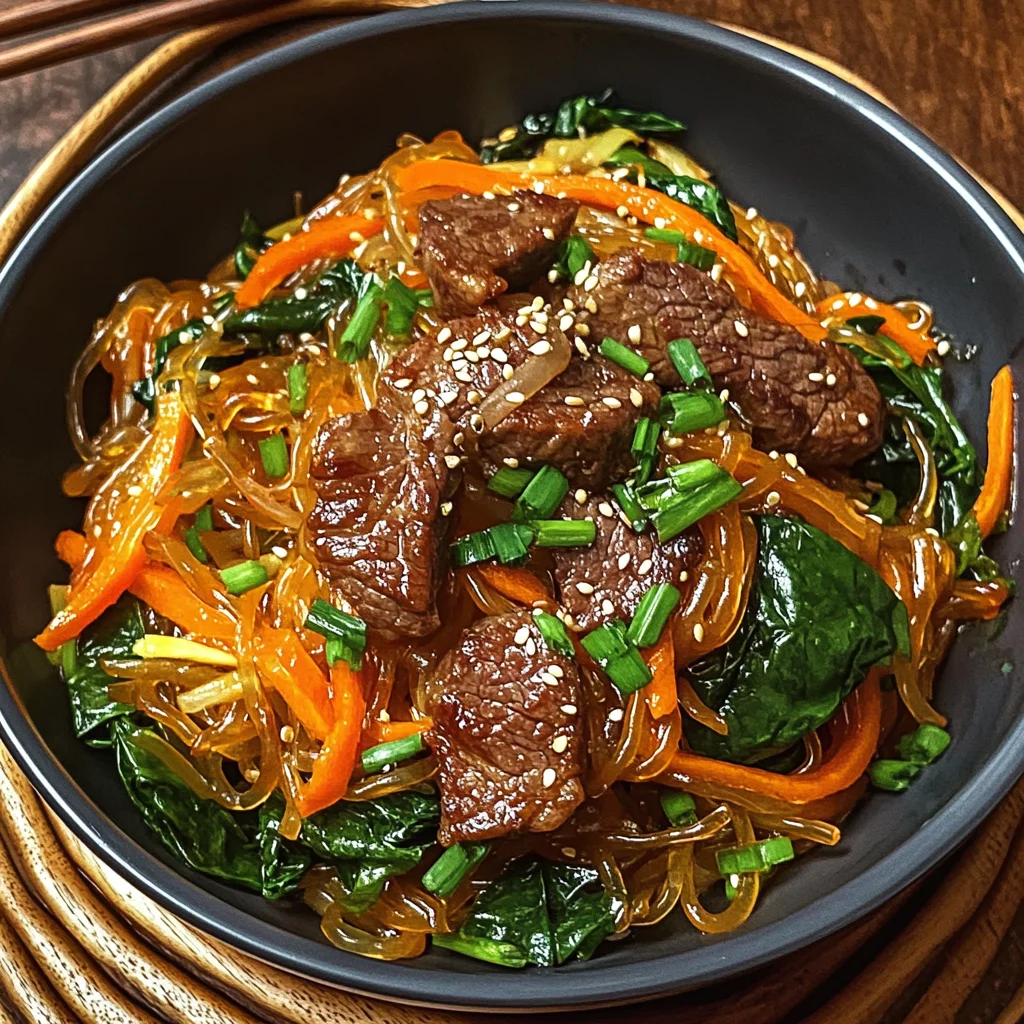
Make Ahead and Storage
Japchae is not only delicious but also perfect for meal prep! You can whip up a big batch ahead of time and enjoy it throughout the week. Follow these guidelines to store your Japchae properly.
Storing Leftovers
- Store leftover Japchae in an airtight container in the refrigerator.
- It will stay fresh for up to four days.
- To keep the noodles from becoming too soft, consider storing the noodles separately from the vegetables and protein.
Freezing
- Allow Japchae to cool completely before freezing.
- Place it in freezer-safe bags or containers, removing as much air as possible.
- It can be frozen for up to three months.
Reheating
- Thaw frozen Japchae in the refrigerator overnight before reheating.
- Warm it in a skillet over medium heat, adding a splash of water or sesame oil to maintain moisture.
- Alternatively, you can microwave it in short intervals until heated through, stirring occasionally.
FAQs
Here are some common questions about making Japchae.
Can I make Japchae without meat?
Absolutely! You can substitute the beef with chicken, tofu, or shrimp, or keep it vegetarian by using only vegetables. The dish is versatile and still delicious!
What makes Japchae special?
Japchae stands out because of its unique sweet potato glass noodles that provide a chewy texture and a subtly sweet flavor. It’s a delightful blend of savory ingredients that makes every bite exciting!
How long does Japchae last in the fridge?
When stored properly in an airtight container, Japchae can last for up to four days in the fridge. Just be sure to separate the noodles from other ingredients if you’re concerned about texture.
Is Japchae gluten-free?
Yes! If you use tamari instead of soy sauce and ensure all other ingredients are gluten-free, you can enjoy this dish without any gluten concerns.
Final Thoughts
I hope this recipe for Japchae inspires you to bring a taste of Korea into your kitchen! With its vibrant flavors and satisfying texture, it’s a dish that truly warms the heart. Enjoy creating this delightful meal for yourself and your loved ones. Happy cooking!
Japchae
Discover the joy of making Japchae, a traditional Korean stir-fried noodle dish that brings together vibrant flavors and delightful textures in every bite. This easy-to-make recipe features chewy sweet potato glass noodles and a colorful medley of fresh vegetables, providing a comforting meal that’s perfect for family dinners or potlucks. Customizable with your choice of proteins like chicken or tofu, Japchae is not only delicious but also incredibly versatile. Whether you’re preparing it for a cozy weeknight dinner or a festive gathering, this dish is sure to impress everyone at the table.
- Prep Time: 15 minutes
- Cook Time: 20 minutes
- Total Time: 35 minutes
- Yield: Serves approximately 6 people 1x
- Category: Main
- Method: Stir-Frying
- Cuisine: Korean
Ingredients
- 1 lb Korean sweet potato noodles (glass noodles)
- 2 lb thin-sliced beef (or substitute with chicken, tofu, or shrimp)
- 3 medium carrots, julienned
- 1 large white onion, thinly sliced
- 1/2 bunch green onions, chopped
- 6 garlic cloves, minced
- 1/2 lb spinach leaves
- 4 tbsp sesame oil
- 1 tbsp olive oil
- 6 tbsp soy sauce
- 3 tbsp brown sugar
Instructions
- Cook the noodles according to package instructions until tender yet chewy (5-6 minutes). Drain and set aside.
- In a skillet over high heat, cook the thin-sliced beef until browned, seasoning with half of the soy sauce, sesame oil, and brown sugar.
- In another skillet, sauté julienned carrots and sliced onion in olive oil until softened. Add remaining soy sauce, sesame oil, brown sugar, garlic, and green onions; cook for an additional minute.
- Stir in fresh spinach leaves until wilted. Combine cooked beef and sautéed vegetables with the prepared glass noodles in a large bowl.
- Toss gently to mix all ingredients thoroughly and serve warm.
Nutrition
- Serving Size: 1 cup (approximately 200g)
- Calories: 410
- Sugar: 10g
- Sodium: 700mg
- Fat: 16g
- Saturated Fat: 3g
- Unsaturated Fat: 11g
- Trans Fat: 0g
- Carbohydrates: 50g
- Fiber: 4g
- Protein: 20g
- Cholesterol: 60mg

